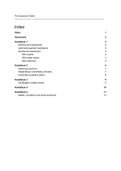Schrödinger equation - Study guides, Class notes & Summaries
Looking for the best study guides, study notes and summaries about Schrödinger equation? On this page you'll find 47 study documents about Schrödinger equation.
Page 4 out of 47 results
Sort by
Summary of the book "The New Quantum Universe" which is mandatory for the course and highly recommended
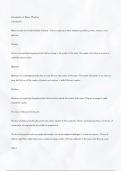
-
introduction to atomic structure
- Summary • 3 pages • 2023
-
- $7.99
- + learn more
Introduction to Atomic Structure This set of notes provides a comprehensive overview of atomic structure, from the basics of protons, neutrons, and electrons to the more advanced topics of quantum mechanics and chemical bonding. The notes are written in a clear and concise style and are illustrated with helpful diagrams and images. They are suitable for students of all levels, from high school to college. The notes cover the following topics: The structure of the atom: What are atom...
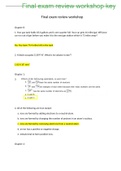
-
Final exam review workshop key
- Exam (elaborations) • 11 pages • 2022
-
- $9.39
- + learn more
1. Your gas tank holds 18.6 gallons and is one quarter full. Your car gets 16 miles/gal. Will your car run out of gas before you make it to the next gas station which is 73 miles away? No. You have 74.4 miles left in the tank 2. A block occupies 0.3597 ft3 . What is its volume in mm3? 1.02 X 107 mm3 Chapter 1: 3. 4. All of the following are true except: a. ions are formed by adding electrons to a neutral atom. b. ions are formed by changing the number of protons in an atom's nucl...
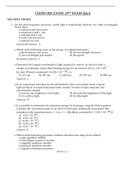
-
CHEM 1021 EXAM |3RD EXAM Q&A
- Exam (elaborations) • 10 pages • 2022
-
- $8.49
- + learn more
CHEM 1021 EXAM |3RD EXAM Q&A MULTIPLE CHOICE. 1. On the electromagnetic spectrum, visible light is immediately between two other wavelengths. Name them. A) infrared and ultraviolet B) microwave and x -ray C) infrared and x -ray D) radio and microwave E) gamma ray and ultraviolet Answer: A 2) Which of the following occur as the energy of a photon increases? A) the frequency decreases. B) the wavelength increases C) the wavelength gets shorter. D) the speed decreases. Answer: C 3) De...

-
Useful physics concepts
- Class notes • 34 pages • 2024
-
- Free
- 1x sold
- + learn more
Wave Optics: Wave nature of light, including interference, diffraction, and polarization. Double-slit experiment and Young's modulus. Fresnel and Fraunhofer diffraction. Quantum Mechanics: Wave-particle duality and the uncertainty principle. Schrödinger equation and its solutions. Quantum states, operators, and observables. Quantum tunneling and the quantum harmonic oscillator. Optical Fibers: Principles of total internal reflection. Construction and operation of optical fibers for ...
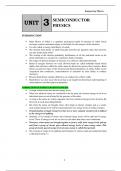
-
basic knowledge of semiconductor
- Class notes • 33 pages • 2024
-
- Free
- + learn more
Wave Optics: Wave nature of light, including interference, diffraction, and polarization. Double-slit experiment and Young's modulus. Fresnel and Fraunhofer diffraction. Quantum Mechanics: Wave-particle duality and the uncertainty principle. Schrödinger equation and its solutions. Quantum states, operators, and observables. Quantum tunneling and the quantum harmonic oscillator. Optical Fibers: Principles of total internal reflection. Construction and operation of optical fibers for ...
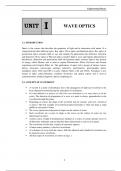
-
Useful physics concepts
- Class notes • 39 pages • 2024
-
- Free
- + learn more
Wave Optics: Wave nature of light, including interference, diffraction, and polarization. Double-slit experiment and Young's modulus. Fresnel and Fraunhofer diffraction. Quantum Mechanics: Wave-particle duality and the uncertainty principle. Schrödinger equation and its solutions. Quantum states, operators, and observables. Quantum tunneling and the quantum harmonic oscillator. Optical Fibers: Principles of total internal reflection. Construction and operation of optical fibers for ...
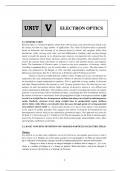
-
optics
- Class notes • 26 pages • 2024
-
- Free
- + learn more
Wave Optics: Wave nature of light, including interference, diffraction, and polarization. Double-slit experiment and Young's modulus. Fresnel and Fraunhofer diffraction. Quantum Mechanics: Wave-particle duality and the uncertainty principle. Schrödinger equation and its solutions. Quantum states, operators, and observables. Quantum tunneling and the quantum harmonic oscillator. Optical Fibers: Principles of total internal reflection. Construction and operation of optical fibers for ...
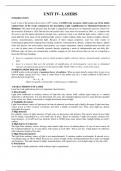
-
lasers
- Class notes • 15 pages • 2024
-
- Free
- + learn more
Wave Optics: Wave nature of light, including interference, diffraction, and polarization. Double-slit experiment and Young's modulus. Fresnel and Fraunhofer diffraction. Quantum Mechanics: Wave-particle duality and the uncertainty principle. Schrödinger equation and its solutions. Quantum states, operators, and observables. Quantum tunneling and the quantum harmonic oscillator. Optical Fibers: Principles of total internal reflection. Construction and operation of optical fibers for ...
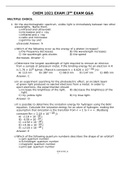
-
CHEM 1021 EXAM |3RD EXAM Q&A
- Exam (elaborations) • 10 pages • 2022
-
- $14.99
- + learn more
CHEM 1021 EXAM |3RD EXAM Q&A MULTIPLE CHOICE. 1. On the electromagnetic spectrum, visible light is immediately between two other wavelengths. Name them. A) infrared and ultraviolet B) microwave and x -ray C) infrared and x -ray D) radio and microwave E) gamma ray and ultraviolet Answer: A 2) Which of the following occur as the energy of a photon increases? A) the frequency decreases. B) the wavelength increases C) the wavelength gets shorter. D) the speed decreases. Answer: C 3) Dete...

That summary you just bought made someone very happy. Also get paid weekly? Sell your study resources on Stuvia! Discover all about earning on Stuvia

